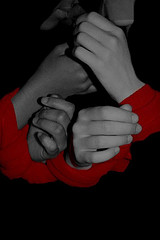 RSS FEED
RSS FEED
Archive for the ‘Tips & Techniques’ Category
Blog Carnival Time: Holiday Stress
December 15th, 2009
Teri Robert is hosting the blog carnival this month at My Migraine Connection. There’s a great collection of  posts on caring for yourself such that you can actually enjoy the holidays. My contribution is just one post down on this page (unless you’re reading on Facebook, if you are, please hop over to Free my Brain). For the rest of the carnival, please go to December Migraine and Headache Disease Blog Carnival: Holiday Stress. And whatever else you do, remember to slow down and breathe!
posts on caring for yourself such that you can actually enjoy the holidays. My contribution is just one post down on this page (unless you’re reading on Facebook, if you are, please hop over to Free my Brain). For the rest of the carnival, please go to December Migraine and Headache Disease Blog Carnival: Holiday Stress. And whatever else you do, remember to slow down and breathe!
Tags: blog carnival, holidays
Posted in Tips & Techniques, Weblogs | Comments (0)
How Can we Work with Migraines?
November 5th, 2009
 disabling disorder. Migraine disease has a very real impact on our careers and our earning capacity. Many of us find we cannot keep up with the schedule, or the stress, or the intellectual demands, of our former jobs. Maybe we can’t work full-time hours, but we can still do productive work. Some of us are partly disabled, or mostly disabled, but don’t qualify for disability income.
disabling disorder. Migraine disease has a very real impact on our careers and our earning capacity. Many of us find we cannot keep up with the schedule, or the stress, or the intellectual demands, of our former jobs. Maybe we can’t work full-time hours, but we can still do productive work. Some of us are partly disabled, or mostly disabled, but don’t qualify for disability income.
I’ve been working from home since 1991, although I have had several part-time jobs at an actual job site since that time. My list is long: I have worked as a per diem attorney; I mediate for divorcing couples; I have done free-lance writing; I have taught school part time; I have worked retail part time; I have run a full-time business as a business coach, and a part-time business as a Migraine management coach. I’ve done a number of these things simultaneously. It hasn’t made me rich, and it has its ups and downs and delays.
- getting accommodations for your Migraines at work under the Americans with Disabilities Act (ADA).
- getting unpaid leave on an as needed basis under the Family Medical Leave Act (FMLA).
- getting Permanent Disability for Migraine disease.
One of the difficulties many of us face, though, is that we may be too impaired to work full time, but not impaired enough to apply for permanent disability. If only there was such a thing as partial disability, that made up the difference between what we’re able to earn now and what we earned before! The remedies available in the law won’t necessarily help you choose how to live with the real-life situations you find yourself in.
It is possible to earn a living working from home, or on a free-lance basis. I can only touch on this subject today, but I hope to add a lot of resources to the site soon to help you find and maintain this kind of work. Is your work something that you could do part-time, or as a substitute? Many professionals may be able to do substitute, per diem, or fill-in work for their professional colleagues. A steady load of this work can take a little while to build up, but is usually available if you’re willing to look for it. You might also consider substitute teaching – substitute teachers in large school districts may get called to teach almost every day.
Work at home jobs can be anything from regular jobs where you work for an employer, clock in on your computer and work regular hours, to a huge variety of free-lance and business opportunities. There are books, blogs and web sites devoted to work at home opportunities. There are new professions like virtual assistants which serve those who work at home, where people with secretarial or administrative skills make them available on a contract basis. Like any other job search, finding work at home will involve focusing in on something you can do and building skills and contacts in that area.
 The hardest part of working at home is the lack of structure, especially if you are working for yourself. I recommend setting working hours and sticking to them – go to work and don’t try to get your housework done at the same time. We Migraineurs have it even harder, we have the interruptions of Migraines on top of the lack of structure of working at home. The best piece of advice I can give you is, get as much support as you can. If you’re going to work on your own, get a coach or a support group to help you stay on track. There is a life between full time work and total disability, and there are lots of us out here living it who’d be happy to support you. The Migraine Support & Coaching Group is available to help you get started and keep going in your work at home venture.
The hardest part of working at home is the lack of structure, especially if you are working for yourself. I recommend setting working hours and sticking to them – go to work and don’t try to get your housework done at the same time. We Migraineurs have it even harder, we have the interruptions of Migraines on top of the lack of structure of working at home. The best piece of advice I can give you is, get as much support as you can. If you’re going to work on your own, get a coach or a support group to help you stay on track. There is a life between full time work and total disability, and there are lots of us out here living it who’d be happy to support you. The Migraine Support & Coaching Group is available to help you get started and keep going in your work at home venture.
– Megan
Tags: Migraine disability, work at home, working
Posted in Managing, Tips & Techniques | Comments (0)
Changing the things we can
October 31st, 2009
 Remember the serenity prayer? God grant me the serenity to accept the things I cannot change, the courage to change the things I can, and the wisdom to know the difference. People ask me how I can coach someone to improve their Migraine profile (frequency and severity of Migraines). Isn’t that in the realm of things we cannot change?
Remember the serenity prayer? God grant me the serenity to accept the things I cannot change, the courage to change the things I can, and the wisdom to know the difference. People ask me how I can coach someone to improve their Migraine profile (frequency and severity of Migraines). Isn’t that in the realm of things we cannot change?
With Migraine disease we are often at the effect of forces we can’t change. We have highly sensitive nervous systems, and we can’t always predict our Migraines. But there are things that we can do, to make a difference for ourselves. I have identified ten areas of our lives where we can take action and make changes that can impact the frequency and severity of our Migraines.
1. Rest & Sleep: Getting 7 – 9 hours of restful sleep per night; going to sleep and waking up at approximately the same time every day; getting to sleep before midnight each night; and taking time during your day to rest when you are tired.
2. Hydration: Drinking at least 2 liters of water or non-caffeinated, non-alcoholic fluid per day; and increasing your fluid intake when you have a Migraine.
3. Nourishment: Eating nourishing food at regular mealtimes; avoiding letting your blood sugar drop or letting yourself get shaky with hunger; avoiding foods that you know trigger you; drinking no more than 2 caffeinated beverages per day; and consuming alcohol only in moderation.
4. Environmental Triggers: Avoiding living or working around extreme noise; avoiding smoking, living or working around smoke; avoiding perfumes or chemical fumes in your living or working environment; using sunglasses and hats to protect yourself from bright light; and working to clear your environment of other triggers.
5. Exercise: Doing some form of physical activity on a daily basis; getting aerobic exercise at least 3 times a week for 20 minutes; and stretching daily.
6. Relaxation: Participating in some form of deliberate relaxation, activating your relaxation response, for at least 30 minutes a day; and taking mental breaks between periods of concentration or intense activity, walking away, changing gears, disengaging, slowing down.
7. Work: Doing work, volunteer work, a hobby or other pursuit that gives you purpose, satisfies and sustains you.
8. Relationships:Being happy with your relationships; and having relationships that are loving, fun, that support you and sustain you, with good communication.
9. Medical Care: Being happy with your communication with your medical providers; being happy with the expertise of your medical providers; and being happy with the care given you by your medical providers.
10. Treatment Options: Being satisfied with your Migraine treatment options; having educated yourself about available treatment alternatives; using your treatments effectively – as directed, when needed; and using complementary medicine and comfort measures to supplement medications.
When I am coaching a Migraineur we look at which area to start working on, which would be the easiest to change, and which would make the biggest difference. We can’t change everything at once; we must have someplace to start. The support of a coach and a group of other Migraineurs helps make and sustain the changes that make a difference.
– Megan Oltman
Tags: Migraine management, migraine management coaching, serenity prayer
Posted in Managing, Tips & Techniques | Comments (0)
Clean up, or Rest and Recover, How Do we Choose?
July 23rd, 2009
 Diana Lee wrote a compelling post recently about the felt need to keep her house clean when she is home on total disability – called “I’m So Lazy: Ways We Trick & Abuse Ourselves“. I could really identify with those undermining tapes that play in our heads, telling us that whatever we are doing, and however sick we may be, we could and should be doing more, and better, and keeping up appearances!
Diana Lee wrote a compelling post recently about the felt need to keep her house clean when she is home on total disability – called “I’m So Lazy: Ways We Trick & Abuse Ourselves“. I could really identify with those undermining tapes that play in our heads, telling us that whatever we are doing, and however sick we may be, we could and should be doing more, and better, and keeping up appearances!
Diana’s post inspired my theme for the Free My Brain Migraine Managment newsletter on this month. (If you’d like to recieve the newsletter you can sign up in the Six Migraine Keys box in the upper right corner of this page.) Here’s what I think about how to choose:
Putting our health first is a mantra, not a rule. A mantra is something we repeat to ourselves and allow it to slowly sink into our subconscious minds, informing our actions. A mantra can be a question or an inquiry
that we live inside of, always asking ourselves, “What would it mean to put my health first, today, in this situation?”
How, in the face of all of life’s demands, paying bills, maintaining a home in some semblance of order, raising children or caring for others, do you put your health first?
Use putting your health first as a mantra and it won’t give you a hard and fast answer in every situation, but  it will give you some guidance. Repeat “I am putting my health first,” as you walk, as you meditate, as you go to sleep at night.
it will give you some guidance. Repeat “I am putting my health first,” as you walk, as you meditate, as you go to sleep at night.
We can’t avoid every Migraine, and sometimes we will choose to work, or do housework or other tasks, even though it triggers an attack or worsens our pain. It is not a perfect world and we can’t magically have all our needs and obligations taken away because we are sick. Part of putting our health first must be to forgive
ourselves in those situations. We must forgive ourselves when we do the task to the detriment of our health, and we must forgive ourselves when we can’t do the task because of our health. You will never get this perfect. We are blessed or cursed with a sensitive nervous system that will go haywire at times, whatever we do. Guilt is essentially unhealthy! “I am putting my health first, and I forgive myself!”
If the mess in the house is driving you berserk, as so many of us relate, try to break the jobs down into tiny pieces. I try to pick up, put away, clean or deal with three things every time I walk into a room. Just three. This way the incredible mess gets dealt with, or at least maintained, a little at a time without wearing me
out. And prioritize, prioritize, prioritize. What’s more crucial today, clean underwear or paying the mortgage? (What? Both, of course!) Maybe you could rinse out two pairs of undies in the sink and pay the bill, leaving the bigger laundry task for tomorrow.
Remember – even healthy people will die with full to-do lists! And if you are just lying down, putting your health first, you are already doing the most important thing. Leave me a comment and let me know how your choosing is going today!
– Megan Oltman
dirty dishes image courtesy of Easternblot – eva
Tags: disability, forgiveness, prioritizing, recovery
Posted in Managing, Tips & Techniques | Comments (0)
Trying to Catch Up when Migraines Interrupt
July 11th, 2009
By the way, it will never happen. The catching up, I mean. We will all die with things on our to-do lists. I am  included in this.
included in this.
I had a mild Migraine yesterday. The good news is that it was mild. I wasted an hour or so at my desk with mild head pain and major brain fog trying to force myself to function. I wasn’t getting anything done, so I went and took my triptan and lay down for awhile. After a couple of hours I was able to think again and the pain was mostly gone, so I went back to work. I had a productive couple of hours, but altogether was only through half of my list for the day. So when the day was really done and I needed to go to bed, I found myself staying on line, tweeting a few more tweets, reading a few more blogs, messing around doing anything but turning out the lights and going to sleep.
Why do I do that? I have such trouble letting go of the day when it doesn’t go the way I want it to. I am aware of the impulse, but yet it’s completely irrational because the hanging round tweeting, keeping myself up, isn’t catching me up or making up for what I lost. Sometimes I wish my Mom was here to tell me to go to bed!
 I have a visualization that I do to complete the day when I lie down to sleep. I picture a room, it’s a pleasant sort of office, with a beautiful view (that’s the view from my office, picture that if you want!), and a big desk, lots of drawers and closets. I visualize all the things I was working on in the day, all the things that happened, one by one, as objects or pieces of paper. A writing project might show up as a piece of paper, a fun conversation I had might be a toy, one by one I review the happenings, projects, and even emotions of the day and picture them in some physical form. And with each one, I find a place to put it away. If there is something I need to remember to do with it tomorrow, I write a note to myself and put it on the desk. I run through this with each and every part of the day until everything is put away, and then I sweep the room and leave. If I’m still awake!
I have a visualization that I do to complete the day when I lie down to sleep. I picture a room, it’s a pleasant sort of office, with a beautiful view (that’s the view from my office, picture that if you want!), and a big desk, lots of drawers and closets. I visualize all the things I was working on in the day, all the things that happened, one by one, as objects or pieces of paper. A writing project might show up as a piece of paper, a fun conversation I had might be a toy, one by one I review the happenings, projects, and even emotions of the day and picture them in some physical form. And with each one, I find a place to put it away. If there is something I need to remember to do with it tomorrow, I write a note to myself and put it on the desk. I run through this with each and every part of the day until everything is put away, and then I sweep the room and leave. If I’m still awake!
Please visit my new products page for recordings of other visualizations that are specifically for relaxation, pain reduction and reducing Migraine triggerability.
As for me, I have to remember sometimes that I have the tools and pick them up sooner. Completing the day to go to sleep makes a lot of sense. Being complete with the fact that I have been interrupted in the course of the day, and that I won’t get it all done – that’s harder for me. How about you?
Tags: letting go, migraine, relaxation exercise, sleep, visualization
Posted in Managing, Tips & Techniques | Comments (0)
Move a Muscle, Change a Thought
June 12th, 2009
Move a Muscle, Change a Thought. I first heard that in a self-help program many years ago. It’s easy to  stay stuck in a certain way of thinking, to stay down and confused and immobilized when we stay in the same place, looking at the same things. Get up, move, do something different, move a muscle, change a thought. There is now all kinds of scientific evidence to back up this idea, of the benefits of physical activity and exercise. I’m not just talking about working out or even taking a walk, though. Just do something to shift, move, change your perspective, take some action, get something moving.
stay stuck in a certain way of thinking, to stay down and confused and immobilized when we stay in the same place, looking at the same things. Get up, move, do something different, move a muscle, change a thought. There is now all kinds of scientific evidence to back up this idea, of the benefits of physical activity and exercise. I’m not just talking about working out or even taking a walk, though. Just do something to shift, move, change your perspective, take some action, get something moving.
This is as true for those of us with Migraine disease and chronic illness as it is for anyone else. Maybe more so. When we are in chronic or frequent pain it’s hard to act on this. I don’t deny it. But as hard as it is, it’s very important. It may be that walking to the mailbox is as far as you can go. It may be that sitting up for an hour instead of lying down is a major challenge. Do it, if you possibly can. We need accomplishment in our lives to make our lives feel worthwhile to us. We need goals, even tiny ones. We need to feel we are contributing, even if the extent of the contribution is to wash 3 of the dirty dishes. There will be those times when we cannot do anything but endure our pain, or when attending to our healing is all we should do, but when it is not one of those times, it is time to be doing something.
We also need the shift in perspective. When you stay in one place for a long time, your world can close in. You can’t see your way out of problems. Moving your body changes what your eyes see, it helps your blood flow, it helps you breathe more fully, and it opens up your thinking.
 I just completed the set of BREESE relaxation recordings which are available on the products page here on Free my Brain. The final BREESE Breathing recording teaches a breathing and movement technique I use to help get the breath and blood moving and the whole body relaxed. You can use this when you have mild head pain, or in the post-drome phase after a Migraine to start moving again and aiding your recovery.
I just completed the set of BREESE relaxation recordings which are available on the products page here on Free my Brain. The final BREESE Breathing recording teaches a breathing and movement technique I use to help get the breath and blood moving and the whole body relaxed. You can use this when you have mild head pain, or in the post-drome phase after a Migraine to start moving again and aiding your recovery.
Another technique taught me long ago is to take a green break. Plants produce the oxygen we need to survive, they also produce negative ions which soothe us. Get outdoors and be with a green growing thing. If you can’t get out, spend a few minutes with a house plant. When all else fails, look out a window at something green, or even look at a picture of trees, fields, the natural world. Get up, leave the house, cross the room, or even roll over and contemplate something green. Let your worries flow out of you into the green growing world. Just as plants use our carbon dioxide, the waste from our breath, to produce oxygen, let the waste of our minds, our worry and anxiety, flow out into the natural world and be transformed.
Life rewards action. There’s another great saying, and I don’t know where I first heard it, but I have found  it to be true, for me and for the people I work with. Here in New Jersey we have had several weeks of almost non-stop rain. It is gray, damp and chilly, except when it’s gray, damp and muggy. Although I don’t trigger at every barometric pressure change like some Migraineurs, I did eventually get a Migraine over the past few days. It was very hard to get up and move. But once the active pain phase had passed, and during a break in the clouds, when it was just drizzling instead of down-pouring, I went out for a walk. I walked gently, doing my relaxation breathing in rhythm with my steps. I came back more optimistic, with the fog of post-drome beginning to lift. I played a game with my kids; I began writing this piece.
it to be true, for me and for the people I work with. Here in New Jersey we have had several weeks of almost non-stop rain. It is gray, damp and chilly, except when it’s gray, damp and muggy. Although I don’t trigger at every barometric pressure change like some Migraineurs, I did eventually get a Migraine over the past few days. It was very hard to get up and move. But once the active pain phase had passed, and during a break in the clouds, when it was just drizzling instead of down-pouring, I went out for a walk. I walked gently, doing my relaxation breathing in rhythm with my steps. I came back more optimistic, with the fog of post-drome beginning to lift. I played a game with my kids; I began writing this piece.
Do what you can to get in action. Little actions can make a big difference. Roll over, shift your perspective. Move a muscle, change a thought. Let me know how I can help!
– Megan
Walk in the light image courtesy of H. Koppdelaney; Rain shower image courtesy of AlmazUK.
Tags: chronic illness, exercise, getting in action, Migraine disease, self-help
Posted in Managing, Musings, Tips & Techniques | Comments (0)
Getting the Support you Need
May 8th, 2009
 If there’s anything that makes me want to throw up my hands and give up, it’s how complex Migraine disease is. Migraine disease has multiple triggers, can take multiple forms with different symptoms and effects on our lives, and has multiple treatment possibilities. I could not manage all of this without support. It’s lonely dealing with a disease that eats away days and weeks of our lives, and isolates us where the sound and the light won’t bother us. Treating Migraine takes managing multiple aspects of our lives and health – that takes support. The people who support me remind me that every day will not be so bad, that life is still worth living, that there is hope. The things that support me give a structure to my life that I can count on when I am not functioning at my best.
If there’s anything that makes me want to throw up my hands and give up, it’s how complex Migraine disease is. Migraine disease has multiple triggers, can take multiple forms with different symptoms and effects on our lives, and has multiple treatment possibilities. I could not manage all of this without support. It’s lonely dealing with a disease that eats away days and weeks of our lives, and isolates us where the sound and the light won’t bother us. Treating Migraine takes managing multiple aspects of our lives and health – that takes support. The people who support me remind me that every day will not be so bad, that life is still worth living, that there is hope. The things that support me give a structure to my life that I can count on when I am not functioning at my best.
We need to cultivate our support systems – building them up when we feel well so they will be there when we need them. We need to do what we can for the people who support us, when we can. In other words, we need to build our stock of resources.
What kinds of support are there? Consider these:
- Professional support – this includes:
- Doctors – you need a good medical doctor to track and coordinate your care and help you find appropriate medication.
- Complementary practitioners – chiropractors, massage therapists, acupuncturists, bio-feedback practitioners, and nutritionists, among others, can help you relax, rechannel your energy, maintain your general health, manage and reduce pain.
- Therapists – migraine is not a psychological disorder! But supportive therapy can help us deal with the emotions our illness causes.
- Coaches – a coach can help you create a plan to manage your life with Migraine and help you generate the energy and enthusiasm to move ahead with your plan. That’s what I do – contact me to hear more about it. Both coaches and therapists can be a great help in picking you up when you are down.
- Personal Support:
- Friends, family members, neighbors, even bosses or co-workers. You will need to make sure that they have some basic information about Migraine and that they know you have a disease. You’ll need to be clear about what kind of support or help you need from them.
- Another great form of personal support comes from other migraineurs, whether you join an online community or group such as my personal favorite, the forum at My Migraine Connection; chat with other Migraineurs on Twitter; join or start a face to face Migraine support group; or get on the phone with other Migraineurs in a relaxation teleclass; or join one of our Managing Life with Migraine teleconferences.
- Medication support – you need medication choices to support you in preventing migraines and stopping them when they occur.
- Tool-kit support – Whatever you use to comfort yourself when you do get a migraine – comfy pillows or blankets, ice packs, hot baths, cups of tea, essential oils, soft music, soft lights, whatever you use to help you to feel better.
- Structure & routine support – this is what you do regularly to make the most of your well time and stay as well as you can. It will include your medications and nutrition, your exercise routine, relaxation routine, sleep routine.
Where is support missing in your life? Sometimes making a list of the pieces that are missing and taking just one step at a time can make a big difference. Like finding one person to talk to, or scheduling one doctor’s appointment. Giving a teleclass a try, or stocking up on comfort supplies.
What can you do to build your support system?
– Megan
Hands together image courtesy of Maria Angelie.
Tags: managing life with migraine, migraine support, Migraine treatment, migraine treatment plan
Posted in Managing, Medicine, Tips & Techniques | Comments (4)
How Do you Relax? (Is it Relaxing you?)
April 8th, 2009
I really do want to know. I’m very curious about this phenomenon – we seem to be so drawn to things that  are fun, or enjoyable, or give us some kind of gratification, but don’t actually relax us. For instance (when in doubt, I’ll always tell one on myself) I am very drawn to playing Snood – a computer game that involves shooting down these silly faces with matching faces – lots of eye-hand coordination, speed, a danger-bar that raises the stress level, electronic music and noises, bright colors on a computer screen – Migraine hell, yes? Why would I want to do that? Is it relaxing? No! Fun? Yes!
are fun, or enjoyable, or give us some kind of gratification, but don’t actually relax us. For instance (when in doubt, I’ll always tell one on myself) I am very drawn to playing Snood – a computer game that involves shooting down these silly faces with matching faces – lots of eye-hand coordination, speed, a danger-bar that raises the stress level, electronic music and noises, bright colors on a computer screen – Migraine hell, yes? Why would I want to do that? Is it relaxing? No! Fun? Yes!
Some people like roller coasters. Gut-wrenching fear. The sense you are about to die. The sensation of your heart about to burst from your chest (not really my cup of tea…). Is that relaxing? That’s a different issue, really. The endorphins your body releases after the ride, when it realizes you have survived, are probably what keeps you coming back. The endorphin rush is very sweet. But is it relaxing?
Now – a walk in the woods. A swim in the ocean, or a lake. A long gentle bike ride. Rocking on a porch swing on a breezy day. Meditating. Yoga. Deep breathing. Guided visualization. A really good laugh. A great talk with a friend. Loving and satisfying sex. A massage. A hot bath. Clearing your mind and practicing letting go. These things truly are relaxing.
When I am working, whether I am writing here on this site, creating more classes for you, working with coaching clients, or doing legal work, I enjoy what I am doing, and I can get into a zone where I just keep rolling and I don’t want to stop. I’ve learned to recognize when I need a break, and I know how important it is to relax. But I will tell you right here and now, it is not easy, even for me. It’s hard to break away. When we’re on a roll, we want to keep rolling. When we’re on the computer, we want to stay on the computer. But what our nervous systems need is for us to shift, to take a break, to practice relaxation.
Deliberate relaxation practice at least three times a week (preferably five) can reduce your Migraine triggerability. How does that work? You will be exercising your parasympathetic nervous system – strengthening your relaxation response. You develop your ability to relax, to release stress, turn off the pressure valve. Deep breathing and guided visualization are two great methods, and I use them in the BREESE relaxation teleclasses. There’s more about the relaxation response in the Free my Brain Migraine Management Newsletter coming out this week, and if you’re not already receiving the newsletter you can sign up for it in the Six Migraine Keys box in the upper right corner of the page.
But I want you to know – I do my relaxation practice, as regularly as I can, and I take breaks and breathe, and take little walks, and do all those things I know I should, but it’s hard! And I still like to do things that are fun, but not particularly relaxing. I’m lucky – I get to lead relaxation classes, so I get a chance to relax with all of you. What do you do to relax?
– Megan
Porch swing image courtesy of Elvissa.
Tags: relaxation practice, relaxation techniques
Posted in Managing, Tips & Techniques | Comments (3)
It’s Blog Carnival Time Again
March 9th, 2009
 The March 2009 Headache and Migraine Disease Blog Carnival is up at Somebody Heal Me. There you can find links to read about a peaceful retreat for weathering a Migraine at Jasmine’s Cove, a very practical three-step approach from Diana Lee, a fantasy trip to the perfect home for Migraine sufferers hosted by yours truly, as well as a sleep apnea mystery solved from James at the Headache and Migraine News Blog, and some thoughts from CI Coach on how hard it is to keep working with chronic illness!
The March 2009 Headache and Migraine Disease Blog Carnival is up at Somebody Heal Me. There you can find links to read about a peaceful retreat for weathering a Migraine at Jasmine’s Cove, a very practical three-step approach from Diana Lee, a fantasy trip to the perfect home for Migraine sufferers hosted by yours truly, as well as a sleep apnea mystery solved from James at the Headache and Migraine News Blog, and some thoughts from CI Coach on how hard it is to keep working with chronic illness!
The Headache & Migraine Disease Blog Carnival has been created to provide both headache patients and people who blog about headaches with opportunities to share ideas on topics of particular interest and importance to us.
For the March 2009 carnival Diana Lee solicited submissions on the topic of “Advice for Creating a Migraine-Friendly Living Environment,” as well as welcoming entries of general interest to headache and migraine sufferers. Happy Reading!
– Megan
Tags: blog carnival, Diana Lee, home environment, Weblogs
Posted in Tips & Techniques, Weblogs | Comments (1)
Creating a Migraine-Friendly Home Environment
March 6th, 2009
 When I was a kid one of the games my brother and sister and I used to love to play on a Saturday was the Farm Game. It involved the Encyclopedia, and a pad and pen. We designed an imaginary farm for the three of us to live on and run, and we would draw it and plan it, and use the Encyclopedia to select our location and all our animals and plants. I’m sure the farms we created would have been impossible to run, with animals that wouldn’t get along, and plant species that wouldn’t grow wherever it was that we were going to be. But it kept us busy for hours, and we loved it.
When I was a kid one of the games my brother and sister and I used to love to play on a Saturday was the Farm Game. It involved the Encyclopedia, and a pad and pen. We designed an imaginary farm for the three of us to live on and run, and we would draw it and plan it, and use the Encyclopedia to select our location and all our animals and plants. I’m sure the farms we created would have been impossible to run, with animals that wouldn’t get along, and plant species that wouldn’t grow wherever it was that we were going to be. But it kept us busy for hours, and we loved it.
Creating the Migraine-friendly home enviroment is a little like that. I could spend hours, and use home design and architecture magazines, catalogs, the web, and a lot of imagination. I could spend bottomless amounts of money I don’t have, to create this environment, have a great time doing it, and I don’t know how practical it would be at the end. But what I’ll try to do here, instead, is mix fantasy and reality, pie in the sky with down to earth, and see if we can come up with some things you can actually use.
Starting outside, the Migraine-friendly home should be well-shaded, with deep covered porches and pollen-free trees. Migraineurs need fresh air and good circulation, but have trouble with extreme heat and bright sun, and often get triggered in high-pollen season. So let’s make it possible to get outside even with a Migraine, and to open the windows and enjoy the fresh air.
Inside, lighting is very important. If you can choose lighting fixtures, great. I discovered the hard way that “high-hat” spot-lights are terrible for me, bright lighting coming down into the top of my eyes is about the worst from a triggering standpoint. Torchiere type lights, which point the light upwards and spread it gently on the ceiling, illuminate the room more indirectly and can give plenty of light without glare. Many Migraineurs find that fluorescents, even compact fluorescents, trigger them. Good old-fashioned shaded incandescent lamps can be good. We just recently got some of the brand new soft-white LED lights, which we have put in the “high-hat” sockets, and they are terrific. Non-flickering, soft illumination, but plenty of it. For the first time, I can have light coming down from above that doesn’t trigger me! They are very good for the environment, too.
Having a quiet place to escape to is key. Lots of my Migraineur friends spend time on the couch, for me it’s my bed. I have 2 kids and a husband who like lots of music and tvs on and I need a place where I can control the light, sound and stimulation level. If you could really set it all up beforehand like the Farm Game you would choose yourself a quiet partner and quiet kids, but I wouldn’t trade the ones I have. I just have to buffer them at times.
Ideally, the Migraine-Friendly home environment would be tidy enough that the Migraineur was not tripping over stuff all the time, without the Migraineur having to be the one to tidy it up all the time. This also falls into the realm of the Farm Game – the ideal Migraine-friendly home environment comes with enough money to hire someone to do the house-keeping. Either that or choose your spouse based on their neatness and housekeeping abilities, though that may not be the best reason to choose your life companion.
Don’t forget to keep what you need for comfort on hand, whether it’s pillows, blankets, eye-shades, ice-packs, comedy DVDs, kitties, doggies, books on tape, spouses, children, best friends, rocking chairs, ginger Altoids, Ben & Jerry’s Heath Bar Crunch, you name it. What else would you add to the design for the Migraine-friendly home?
– Megan
P.S. No, that is not a picture of my house. I wish!
Wisconsin Farm image courtesy of Randen Pederson; craftsman house image courtesy of David Sawyer.
Tags: LED lights, lighting, Migraine triggers
Posted in Managing, Musings, Silliness, Tips & Techniques | Comments (1)
That disclaimer thing...
Remember: nothing we do here is medical advice or treatment or is a substitute for medical advice or treatment. Get competent medical advice to learn more about your migraines, possible treatments and risks.
What's New on Migraine Support Group Coaching |
Recent Comments
- on Calling all Redheaded Migraineurs
- on No, You’re not Crazy, You just Have Migraines
- on No, You’re not Crazy, You just Have Migraines